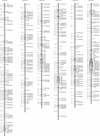Expanded genetic map of Gibberella moniliformis (Fusarium verticillioides)
- PMID: 11916720
- PMCID: PMC123879
- DOI: 10.1128/AEM.68.4.1972-1979.2002
Expanded genetic map of Gibberella moniliformis (Fusarium verticillioides)
Abstract
Gibberella moniliformis (Fusarium verticillioides) is primarily a pathogen of maize, but it can also cause disease in other crop species. This pathogenicity, as well as the contamination of food- and feedstuffs with the fumonisin mycotoxins, results in economically significant losses to both farmers and food processors. The dissection of important biological characters in this fungus has been hampered by the lack of a uniformly dense genetic map. The existing restriction fragment length polymorphism-based map contains significant gaps, making it difficult to routinely locate biologically important genes, such as those involved in pathogenicity or mycotoxin production, with precision. We utilized amplified fragment length polymorphisms (AFLPs) to saturate the existing genetic map and added 486 AFLP markers to the approximately 150 markers on the existing map. The resulting map has an average marker interval of 3.9 map units and averages approximately 21 kb/map unit. The additional markers expanded the map from 1,452 to 2,188 map units distributed across 12 chromosomes. The maximum distance between adjacent markers is 29 map units. We identified AFLP markers less than 1 map unit from the mating type (MAT) locus and 2.5 map units from the spore killer (SK) locus; eight AFLP markers map within 8.5 units of the FUM1 (fumonisin biosynthetic) locus. The increased saturation of this map will facilitate further development of G. moniliformis as a model system for the genetic and population genetic studies of related, but less genetically tractable, plant pathogenic fungi.
Figures


References
-
- Brown, D. W., S. P. McCormick, N. J. Alexander, R. H. Proctor, and A. E. Desjardins. 2001. A genetic and biochemical approach to study trichothecene diversity in Fusarium sporotrichioides and Fusarium graminearum. Fungal Genet. Biol. 32:121-133. - PubMed
-
- Chaisrisook, C., and J. F. Leslie. 1990. A nuclear gene controlling perithecial pigmentation in Gibberella fujikuroi (Fusarium moniliforme). J. Hered. 81:189-192.
-
- Correll, J. C., C. J. R. Klittich, and J. F. Leslie. 1987. Nitrate nonutilizing mutants of Fusarium oxysporum and their use in vegetative compatibility tests. Phytopathology 77:1640-1646.
Publication types
MeSH terms
Substances
LinkOut - more resources
Full Text Sources

